|
|
|
Sort Order |
|
|
|
Items / Page
|
|
|
|
|
|
|
| Srl | Item |
| 1 |
ID:
162919


|
|
|
|
|
| Summary/Abstract |
In this study, we collected Japanese nuclear power plant construction cost data from official documents submitted by the electric utilities and conducted a quantitative analysis of the past trends. We found that the unit construction cost of Japanese nuclear power plants rose during the period from 1975 to 1980, when the “improvement and standardization” programs took place, and did not increase or decline significantly after that. We also observed significant economies of scale, even if we take into account interest during construction, as well as the so-called overnight cost. As far as we know, this study is the first attempt to analyze the total history of Japan's nuclear power generation until the Fukushima accident from the cost perspective. The findings could contribute to a better understanding of the economics of nuclear power, as similar studies in the United States and France tend to exhibit different results. The analyses in this study appear to reinforce the reliability of the cost estimation by the Japanese government, which has been used as the numerical basis for the current energy policies in Japan.
|
|
|
|
|
|
|
|
|
|
|
|
|
|
|
|
| 2 |
ID:
162894
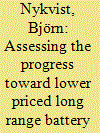

|
|
|
|
|
| Summary/Abstract |
The aim of this study is to show the progress in attributes and prices of battery electric vehicles (BEV) and to analyse in which market segments long range BEV can be produced at comparable cost to conventional cars. We assess 48 models available to consumers since 1997, collecting data on attributes, weight and vehicle prices. We also provide an analysis of recent progress in battery pack costs. Based on this data, the share of BEV vehicle price that is related to the battery pack is modelled. To illustrate future progress we estimate when it is possible to produce a BEV with a 200 mile range in a given price percentile. We find that the price percentile where the price of a BEV is comparable to conventional cars changes in a nonlinear way when battery pack costs fall below 200–250 USD/kWh. Furthermore, we show that battery pack costs of 150 USD/kWh could imply that production costs of a BEV with a 200 mile range are cost competitive for almost 50% of the US car market segments by 2020. Finally, the most critical conditions for this development are discussed and assessed by sensitivity analysis applying conservative values to our model.
|
|
|
|
|
|
|
|
|
|
|
|
|
|
|
|
| 3 |
ID:
162917
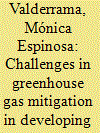

|
|
|
|
|
| Summary/Abstract |
CO2eq emission scenarios for the Colombian transport sector were estimated for 2010–2050. We used a marginal abatement cost approach to assess an emission mitigation pathway. For this purpose, we constructed a carbon emission accounting model linking travel demand to vehicle stock, fuel consumption, and emissions for the Colombian transport sector. Actions related to energy efficiency, fuel switching, new engine technologies and modal change were considered. The analyzed measures have the potential to reduce the cumulative emissions by 8% and 18% under the BAU scenario through 2030 and 2050, respectively. Mitigation costs are high and imply annual capital costs that range from 0.5% to 4% of the national GDP. Gains in efficiency as well as synergy with other sector objectives might help justify some of the actions in financial terms. Non-technological actions, such as high public transit participation in the urban modal share and reorganization of the freight system, play a significant role in attaining low-carbon transport systems in Colombia.
|
|
|
|
|
|
|
|
|
|
|
|
|
|
|
|
| 4 |
ID:
162900


|
|
|
|
|
| Summary/Abstract |
The extreme degree of openness of contemporary urban systems with regard to both economy and population creates a serious challenge for the study of urban energy metabolism. A novel tool based on Multi-Scale Integrated Analysis of Societal and Ecosystem Metabolism (MuSIASEM) is proposed to overcome these challenges. It consists of an end-use matrix, a coherent multi-level integrated characterization of the uses of different forms of energy carriers (electricity, heat, fuels) for the various tasks performed in the city, including private and public mobility, tourism, commercial and residential activities. The end-use matrix integrates quantitative data referring to different dimensions (i.e. energy, human activity, land use, value added) and hierarchical (economic sectors and functional elements at lower levels) and spatial scales (i.e. individual buildings, neighborhoods, and the city as a whole). The end-use matrix provides information on both extensive (flows) and intensive variables (flow/fund ratios or benchmarks). Benchmarks are important for policy-making and allow a meaningful comparison of energy performance across hierarchical levels within the urban system, and among different urban systems. The approach is illustrated for Barcelona, a global city characterized by an important service sector.
|
|
|
|
|
|
|
|
|
|
|
|
|
|
|
|
| 5 |
ID:
162899
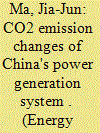

|
|
|
|
|
| Summary/Abstract |
With the rapid development of economy, China's electric power consumption has increased sharply. Its carbon emissions derived from power generation now accounts for more than 45% of the national emissions. This study employs a structural decomposition analysis based on input-output subsystem model to explore sources for emissions increments in China's power sector from 2007 to 2015. Under this approach, the influential factors are classified into four categories. Quite a few scenarios are designed to further assess the impacts of power mix and the levy of carbon tax. The results show that the consumption is the main driving growth factor of CO2 emissions, and most of the emissions are driven by continuing expansion of large-scale infrastructure, and this trend seems going to change in the future; carbon tax and price policies may be the alternative for reducing the emissions. In addition, both the generation efficiency and internal industrial structure are critical factors in emission reduction. Besides, cleaner energy sources effectively lead to carbon emission reduction but this change performs a relatively small effect. Finally, promoting the development of non-fossil energy power may lead to total CO2 emissions perform decrease trend before 2030.
|
|
|
|
|
|
|
|
|
|
|
|
|
|
|
|
| 6 |
ID:
162916


|
|
|
|
|
| Summary/Abstract |
Regional air pollution is strongly impacted by transportation emissions. Policy mechanisms to reduce emissions are required to reach environmental quality goals. Projecting the drivers (e.g., technical, economic, societal, regulatory) that will impact future emissions is challenging, and assessing regional air quality (AQ) is complicated by the need for detailed modeling tools and data inputs to simulate chemistry and transport of pollutants. This work assesses the contribution of emissions from transportation sources to ground-level concentrations of ozone and fine particulate matter via two methods. First, impacts are quantified for three U.S. regions including California using output from an economic optimization model to grow a base year emissions inventory to 2055. Second, impacts are considered for California using state-level projections with an updated emissions inventory and modeling suite in 2035. For both, advanced AQ models are used, showing that the impacts of light duty vehicles are moderate, reflecting shifts to more efficient and lower emitting technologies. In contrast, heavy duty vehicles, ships, and off-road equipment are associated with important ozone and PM2.5 burdens. Emissions from petroleum fuel production and distribution activities also have notable impacts on ozone and PM2.5. These transportation sub-sectors should be the focus of future emissions reduction policies.
|
|
|
|
|
|
|
|
|
|
|
|
|
|
|
|
| 7 |
ID:
162918


|
|
|
|
|
| Summary/Abstract |
Electricity grid resilience in the face of unending hazards plays a crucial role in energy security of a nation. Based on hazard impact variability across different regions of Nigeria, formulating and implementing a contextualized environmental hazard mitigation policy to reduce grid vulnerability to the multiple effects of hazards and disasters is a strategic imperative that can result to longevity of grid networks, with increased probability of critical success factors such as safety, reliability of electricity supply and electricity access in the Sudan Sahel region of Nigeria. Policies outlined in the Nigeria's National Disaster Management Framework (NDMF) and the scope of its National Disaster Response Plan (NDRP) takes no cognizance of the peculiar environmental hazards and disasters that impinges on sustainability of electricity grid infrastructures, and the mitigation strategies to reduce their risks, with reference to the Sudan Sahel region. This paper provides insight on the Sahelian hazards, overview shortcomings of the NDMF and NDRP, and advocates for the contextualization of hazard mitigation policy for electricity grids in the Sudan Sahel based on international best practices and findings of field surveys of the Zamfara Sahel.
|
|
|
|
|
|
|
|
|
|
|
|
|
|
|
|
| 8 |
ID:
162906
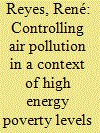

|
|
|
|
|
| Summary/Abstract |
Firewood is the main fuel used for heating in Chile, but its inefficient use is producing severe episodes of air pollution. To address this issue, authorities implement Air Pollution Management Plans (PDAs), which include actions such as setting moisture requirements for firewood, replacing old wood-stoves, temporarily banning the use of firewood, and improving homes´ thermal insulation. However, PDAs do not focus on nor do they prioritize measures in relation to specific social contexts. This study assessed socio-economic variables, energy consumption and indoor environments in households located in the city of Valdivia, through surveys and the monitoring of temperatures and indoor air pollution levels. We found that, during the winter months, 68% of the time living room temperatures were below 21 °C, and PM2.5 concentrations were above international standards. Furthermore, over 61% of households were to suffer a state of energy poverty. We urge decision-makers to consider social inequalities and energy consumption patterns in cities with high firewood consumption, prioritizing measures and focusing resources on reducing both air pollution and energy poverty. Thermal insulation of homes should be a priority in mid-to-low-income families, since these have the highest levels of energy demand. Other PDA´s measures could be economically regressive in these social-strata.
|
|
|
|
|
|
|
|
|
|
|
|
|
|
|
|
| 9 |
ID:
162897


|
|
|
|
|
| Summary/Abstract |
We use a detailed power sector model, E4ST, to project multi-decade effects of preventing a set of unprofitable generators from retiring. We simulate the “Grid Resiliency Pricing Rule” proposed by the US Department of Energy in 2017, and several variations, as an illustrative case study for similar national, regional, or state policies in the US or elsewhere. In the proposed policy, eligible coal and nuclear generators would be guaranteed revenues sufficient to ensure profitability. The simulation results show that, in 2025, $7.6 billion in subsidy is required to guarantee coal and nuclear generator profits. If in effect from 2020 to 2045, the policy delays the retirement of 25 GW of coal capacity and 21 GW of nuclear capacity, causes 27,000 premature deaths, increases carbon dioxide emissions by 420 million short tons, and has costs with a net present value of $263 billion during that period. The policy's net non-environmental cost for electricity end-users is $72 billion and net benefit for generation owners is $28 billion. In alternative scenarios, preventing retirement of only nuclear capacity produces positive total net benefit, while guaranteeing recovery of only going-forward costs shifts $77 billion of costs from customers to generators, but does not reduce emissions or total net cost.
|
|
|
|
|
|
|
|
|
|
|
|
|
|
|
|
| 10 |
ID:
162922
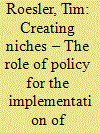

|
|
|
|
|
| Summary/Abstract |
Visions of alternative and more sustainable energy systems are commonly associated with the development and innovation of renewable energy technologies. Geels (2002) notes that regime transition is affected by a set of technological, socio-economic, organisational, political, institutional and region-specific dimensions that can be triggered by niche developments. Indeed, the transition toward a sustainable energy regime is strongly influenced by governance and regulatory frameworks extending from a global to a local scale, which set boundaries and incentives for the direction in which energy transition can evolve. Since 2007, several local initiatives have emerged in the county of Marburg-Biedenkopf in Germany promoting the use of biomass on a local scale. These initiatives successfully established locally owned cooperatives to run a decentralised heating supply infrastructure to supply their households. This paper highlights the role of multi-scalar policy processes that are allowing for the development of bioenergy villages and provides details on the role of regional and local policy processes. Supplementing the national policy framework with regional and local policy makers is a key factor in implementing bioenergy villages.
|
|
|
|
|
|
|
|
|
|
|
|
|
|
|
|
| 11 |
ID:
162902
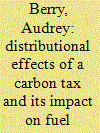

|
|
|
|
|
| Summary/Abstract |
This paper studies the distributional effects of France's recently introduced carbon tax. Using a microsimulation model built on a representative sample of the French population from 2012, it simulates the taxes levied on each household's consumption of energy for housing and transport. Without revenue recycling, the carbon tax is regressive and increases fuel poverty. From a policy perspective, this finding indicates that the question of fuel poverty cannot be ignored in the quest for a fair ecological transition. It proposes that some of the revenues from the carbon tax should be redistributed to households. Different designs of cash transfer to support households are then compared. The results show that the inequities of the carbon tax could be offset at reasonable cost relative to total carbon tax revenues. However, adjusting the design of cash transfers to criteria other than income level does not diminish the cost of compensating households. The benefits of finely adjusting cash transfers may therefore be somewhat limited. Most notably, the results show that targeting revenue recycling at low-income households would help to reduce fuel poverty substantially. This study therefore indicates that carbon taxation actually provides an opportunity to finance ambitious policies to fight fuel poverty.
|
|
|
|
|
|
|
|
|
|
|
|
|
|
|
|
| 12 |
ID:
162904


|
|
|
|
|
| Summary/Abstract |
Saunders and Bedford (2017) demonstrated that income levels are inadequate for some Australian households to maintain a basic standard of living. Analysing utility bills can extend this consideration of income adequacy issues given the essential nature of services such as electricity, telephony and water. This article builds on the work presented by Simshauser and Nelson (2014) about key demographic cohorts in Australia that have a high incidence of energy-related financial hardship. Our analysis indicates that energy related financial hardship is likely to be related to a combination of the following: family formation demographics; low-income (often reliant upon government income support); higher household size; and higher than average consumption. Our policy recommendations are relatively straightforward: development of tools to allow easier ‘shopping around’ by energy customers; cessation of credit-checking by energy retailers as a means of restricting access to energy offers; reform of state-based concessions frameworks; a lifting of income support for some key cohorts (e.g. unemployed); improvements to energy-efficiency standards; and amendments to tenancy laws to overcome potential principal-agent issues associated with uptake of new energy products and services such as embedded solar PV and battery storage.
|
|
|
|
|
|
|
|
|
|
|
|
|
|
|
|
| 13 |
ID:
162890


|
|
|
|
|
| Summary/Abstract |
This article discusses a new method for the sizing of operating reserves by electric power system operators. Operating reserves are used by system operators to deal with unexpected variations of demand and generation, and maintain a secure operation of the system. This becomes increasingly challenging due to the increasing share of renewable generation based on variable resources. This paper revisits the current sizing method applied in Belgium, which is based on a static approach that determines the required capacity once a year. The presented dynamic sizing method determines the required capacity on a daily basis, using the estimated probability of facing a system imbalance during the next day. This risk is estimated based on historical observations of system conditions by means of machine learning algorithms. A proof of concept is presented for the Belgian system, and demonstrates that the proposed methodology improves reliability management while decreasing the average capacity to be contracted. The method is compliant with European market design, and the corresponding regulatory framework, and is of particular interest for systems with a high share of renewable generation. For these reasons a gradual implementation in Belgium towards 2020 has been decided based on the results of this study.
|
|
|
|
|
|
|
|
|
|
|
|
|
|
|
|
| 14 |
ID:
162893


|
|
|
|
|
| Summary/Abstract |
Concentrated Soar Power (CSP) systems can be equipped with capacity to store heat energy enabling generation at night or other times when there is little or no solar irradiation. Proposals for high penetration or 100% renewable energy supply systems therefore often envisage major dependence on the CSP component of the system to help solve the intermittency and storage problems. However there is little evidence on the extent to which this can be done when solar radiation is poor. This study draws on some recently available information to clarify the issue with respect to the proposed Aurora plant for South Australia. It finds that there would be periods of a week or more in which little energy was being produced, and therefore that CSP is unlikely to be capable of making a significant contribution to the storage task in unfavourable conditions.
|
|
|
|
|
|
|
|
|
|
|
|
|
|
|
|
| 15 |
ID:
162909
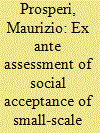

|
|
|
|
|
| Summary/Abstract |
Social acceptance is a relevant determinant of the development of agro-energy systems because its absence can cause delays or even the abandonment of innovative projects. This paper aims at an ex ante assessment of the socio-political acceptance of small-scale agro-energy systems in rural areas located in southern Italy, according to the bioenergy village approach. Starting from a theoretical model, we investigated the key factors influencing the perception of the risks and benefits of the realization of a biomass combustion plant, by a statistical survey on a sample of 152 members of the local community living in eight municipalities located in a rural area. Through exploratory and confirmatory statistical analyses, we identified two key factors: (a) the economic, environmental, and social benefits for the community and (b) reassurance from the energy company management. This research shows that it is very important to consider these elements in order to facilitate dialogue and the debate within the local community. In this way, the involved actors will be enabled to express their expectations to decision makers and policymakers, thus contributing to the steering of the project. In other words, community involvement and the democracy of the energy policy processes are favoured.
|
|
|
|
|
|
|
|
|
|
|
|
|
|
|
|
| 16 |
ID:
162907


|
|
|
|
|
| Summary/Abstract |
Many countries have introduced various policies to improve the energy efficiency of home appliances. Japan introduced the Top Runner Program in 1998 to set efficiency standards for major home appliances. Although the energy efficiency of home appliances significantly improved after the implementation of the program, household electricity consumption has also increased. Using micro-level data from the National Survey of Family Income and Expenditure, we conduct conditional demand analysis to show how energy savings have been lost after the Top Runner Program. We find that households began spending more electricity on space cooling and food preservation after the implementation of the program. Although electricity consumption per air conditioner (AC) has decreased, the number of ACs per household has increased. Conversely, electricity consumption per refrigerator (REF) has increased because households have started buying bigger REFs. The energy savings obtained by the Top Runner Program was lost by the size and stock increases of home appliances. If a household increases the size and stock of home appliances, then it will not be possible to reduce the household electricity consumption by simply improving the energy efficiency of appliances.
|
|
|
|
|
|
|
|
|
|
|
|
|
|
|
|
| 17 |
ID:
162903


|
|
|
|
|
| Summary/Abstract |
Technology rejection phenomenon manifests itself differently across different societies. Over the past two decades, low income households in Soweto have persistently rejected prepaid electricity meters. Until now, the basis of the rejection in the region remains scientifically underexplored. We therefore conduct an exploratory study pertaining prepaid meter rejection in Soweto. Through triangulation research and survey approach, 88 households based in Orlando East and Diepkloof were interviewed by means of a questionnaire. Our study identifies three factors that could potentially be linked to the rejection of prepaid electricity meters in Soweto, namely: lack of quality consultation and education, the high levels of electricity consumption, and unattainable politically motivated promises are the main reasons that currently fuel prepaid meter rejection. We emphasise that the current state of the Free Basic Electricity (FBE) policy also fuels rejection, as it remains socio-economically inadequate and irrelevant for indigent households. We therefore note the need for an FBE policy review and update as well as the establishment of a policy monitoring committee to ensure implementation and enforcement. This study should be regarded as an exploratory study pending a more systematic causal analysis in the future.
|
|
|
|
|
|
|
|
|
|
|
|
|
|
|
|
| 18 |
ID:
162925
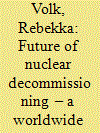

|
|
|
|
|
| Summary/Abstract |
In the 1950s, nuclear power generation became important and many facilities were built. Today, because of political, technical or economic reasons many reactors are being or will be decommissioned. This highly impacts energy policy regarding future energy supply and the handling of decommissioning, including dismantling capacities, regulatory control, equipment, expertise, funding or final nuclear disposal sites.
|
|
|
|
|
|
|
|
|
|
|
|
|
|
|
|
| 19 |
ID:
162910


|
|
|
|
|
| Summary/Abstract |
There is growing consensus on the fact that fossil fuel subsidies provided by governments in high-income countries represent a misalignment on emissions’ reduction with the global climate agenda. In addition, a discussion emerged on the negative socio-economic and environmental externalities associated with fossil fuel subsidies. Nevertheless, pathways for phasing out fossil fuel subsidies in high income countries and their implications on the low-carbon transition have not yet been assessed. With the aim to narrow this knowledge gap, we extend the EIRIN Stock-Flow Consistent behavioral model to study the implications on sustainable development of the gradual phasing out of fossil fuels subsidies, whose revenues could be used by the government to subsidize energy investments in green capital (e.g. solar panels), either via fiscal policies or green bonds. We assess the effects on green growth, employment, credit and bonds market, as well as the distributive effects across heterogeneous households and sectors. A smooth phasing out of fossil fuels subsidies contributes to improve macroeconomic performance, to decrease inequality and helps the government to find fiscal space to support stable renewable energy policies. Renewable energy subsidies contribute to foster the low-carbon transition but could imply distributive effects, depending on the way in which they are implemented.
|
|
|
|
|
|
|
|
|
|
|
|
|
|
|
|
| 20 |
ID:
162901


|
|
|
|
|
| Summary/Abstract |
Local governments are agile policy makers expected to make significant contributions to climate change mitigation through local legislation. One mitigation mechanism available to local governments is to make it easier for households to install solar photovoltaic (PV) panels that generate emission-free electricity. Streamlining PV permitting policies is currently being promoted in states such as California as a way to boost rates of residential solar installation. Fixed effects modelling is used to examine whether streamlining permitting for PV increased rates of PV installations in California prior to 2013. To fill a gap in longitudinal data on implementation dates of local policies to support PV, a combination of surveys, partial databases, and publicly available city-level information is utilized to build a complete picture of changes in relevant policies from 2005 to 2013. Modelling results are unable to reject the null hypothesis that the implementation of streamlined permitting has no effect on residential PV installation rates. This highlights the limitations of what can be assessed given the current sparsity of data on city-level policy changes even employing significant original data collection and compilation.
|
|
|
|
|
|
|
|
|
|
|
|
|
|
|
|
|
|
|
|
|